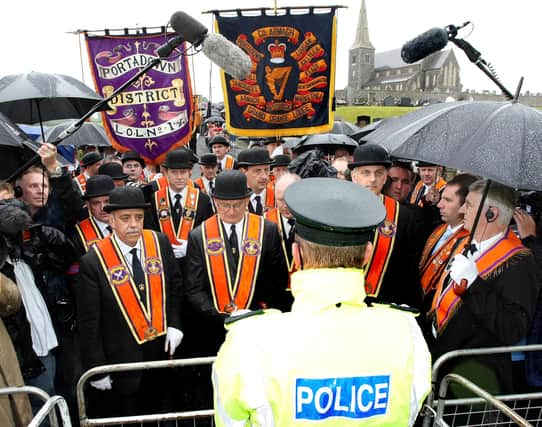Ruth Dudley Edwards: The Orange Order was not to blame for problems around parading disputes


It helps that unionists are so terrible at public relations.
Events at Drumcree 25 years ago are being revisited, and I feel weary that so many commentators still seem to have stuck with the traditional nationalist line.
Advertisement
Hide AdAdvertisement
Hide AdLast week I read an article by the well-regarded Irish Times columnist Kathy Sheridan. Horrified that Patrick Costello, a Green TD, had suggested making the Twelfth a national holiday, she pointed out that a) the Orange Order had never acknowledged responsibility for its role in the deaths, injuries and destruction caused by its insistence on walking its traditional route down the Garvaghy Road, and b) that it is “intrinsically” anti-Catholic.
On a), in the 1990s, having been a close observer of, and reporter on, mayhem over Drumcree and other loyal orders’ contested parades, I soon learned these crises had been deliberately caused by the Provisional IRA, and that its well-scripted mouthpieces were brilliant at winding up and then blaming the Prods.
The Provos had the advantage of not worrying about casualties, which, as always, were acceptable collateral damage in the fight for a united Ireland and anyway someone else’s fault.
Although I was deeply condemnatory of Orange extremists, the articles I wrote at the time describing the cynical setting up of residents’ groups were up against a tidal wave of PIRA propaganda and the media mostly ran with well-crafted fiction rather than messy truth.
Advertisement
Hide AdAdvertisement
Hide AdTo those who don’t believe the IRA were behind it all, may I quote Gerry Adams himself, who had preached the blameless-Catholic-victims message non-stop, but was caught on a tape in November 1997, after the third massive confrontation at Drumcree, taking the credit. “Ask any activist in the north, did Drumcree happen by accident and they will tell you ‘no’. Three years of work on the Lower Ormeau road, Portadown and parts of Fermanagh and Newry, Armagh and in Bellaghy and up in Derry. Three years of work went into creating that situation and fair play to those people who put the work in. They are the type of scene changes that we have to focus on and develop and exploit.”
Among clever ways of driving the message home, in all disputed areas appeared murals showing a faceless bowler-hatted figures in suit and collarette with a heavy line through it and the legend ‘NO CONSENT NO PARADE’.
Very few residents in the affected areas welcomed disorder, but those who not merely quietly opposed such violence but were outspoken against it were bullied and intimidated by the agitators being bussed in.
In the second year of the Drumcree standoffs, there appeared a huge new mural in the Falls Road. I quote from the book I wrote about all this: “Bearing the heading ‘NOT ALL TRADITIONS DESERVE RESPECT’, it featured hooded and robed Ku Klux Klan horsemen with an orange sash riding across a green landscape littered with skulls as well as with rocks daubed with the names of the places where Sinn Féin-IRA had with mixed success been trying to drive the loyal orders wild: Derry, Garvaghy, Ormeau, Dunloy, Castlederg, Enniskillen, Rosslea, and Bellaghy.”
Back to Katy Sheridan’s point b).
Advertisement
Hide AdAdvertisement
Hide AdShe quoted the late Reverend Brian Kennaway’s remarks about the first core value of the Orange institution being “the preservation and propagation of the Protestant religion”. But pro-Protestant is not the same as anti-Catholic. Kennaway, who became a very dear friend of mine, loathed sectarianism.
He was one of the Orangemen who with the new Grand Master of the Orange Order, Robert Saulters, travelled to Harryville in January 1997 to protest outside the Catholic church against the loyalists (some of them Orangemen) who were intimidating mass-goers. Their banner read ‘ORANGEMEN SUPPORT CIVIL AND RELIGIOUS LIBERTY FOR ALL’.
A proud citizen of the UK, he was extremely popular with those from the south who got to know him and recognised him for the kind, open, friendly tolerant guy he was. He became a much-admired president of the Irish Association.
Just for the record, if you’re trying to decide what is truth and what are lies, never trust anyone who believes that there was no alternative to IRA violence.
• Ruth Dudley Edwards is the author of The Faithful Tribe: an intimate portrait of the loyal institutions